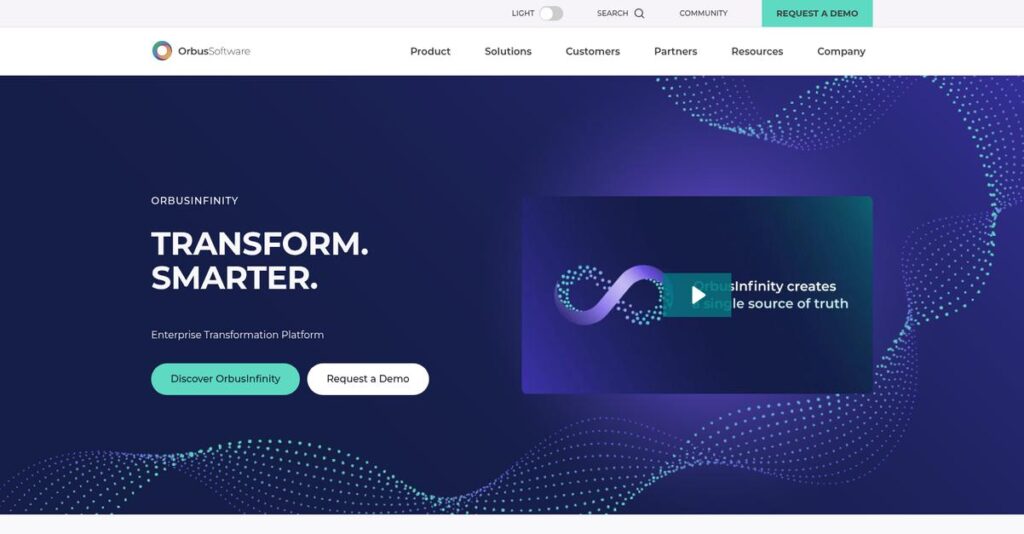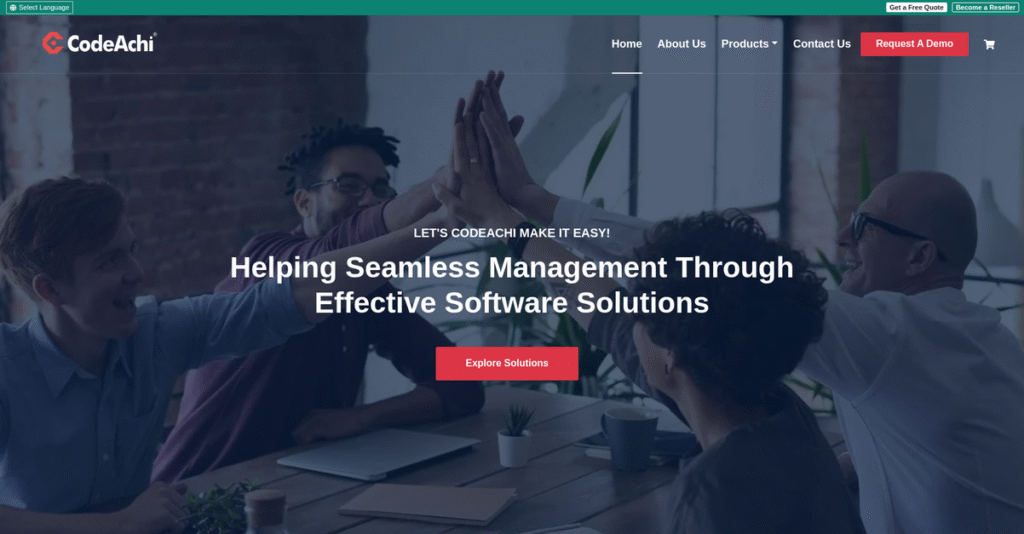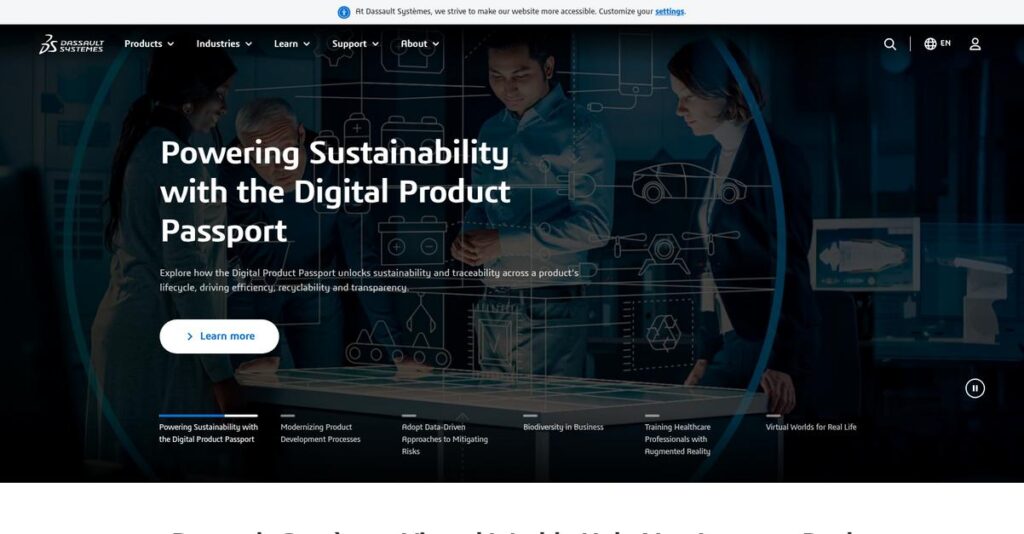Production chaos slowing down your business?
If you’re constantly fighting disconnected systems to keep production running smoothly, you’re not alone—and it’s probably why you’re evaluating Abas for your next ERP upgrade.
My research shows: wasted hours on manual coordination hurt profits when your shop floor, warehouse, sales, and finance are all out of sync.
What I found is that Abas stands out by bringing every piece together—you get tightly integrated production planning, true shop floor control, proactive warehouse tracking, and a built-in CRM, all purpose-built for mid-sized manufacturers with complex needs.
In this Abas review, I’ll break down how Abas can truly unify your entire operation so you stop relying on spreadsheets or patchwork workarounds.
You’ll see detailed analysis of core features, unique workflow strengths, my take on pricing, real usability factors, and where Abas stacks up versus other ERP choices.
You’ll get the insight and clarity you need to pick the features you need to move your operation forward.
Let’s dive into the review.
Quick Summary
- Abas is a flexible ERP system designed to manage complex manufacturing and distribution processes for mid-sized businesses.
- Best for mid-market discrete manufacturers needing tailored production and project management solutions.
- You’ll appreciate its deep customization capabilities that handle unique workflows and integrate all core business functions.
- Abas offers custom pricing based on modules and users with no free trial, requiring a direct demo through their sales team.
Abas Overview
Abas has been around since 1980, hailing from Germany. What impressed me most is their consistent, decades-long mission: building flexible ERP for complex mid-sized manufacturers.
What truly sets them apart is their unwavering focus on mid-sized discrete manufacturing companies. You won’t find them trying to serve every industry; they specialize in complex assembly, custom machinery, and challenging project-based production environments.
For this Abas review, I found their 2019 acquisition by ERP group Forterro was a key development. It provided crucial stability while preserving their specialized product roadmap.
Unlike general-purpose cloud ERPs like NetSuite, Abas deliberately prioritizes deep, granular manufacturing control above all else. My analysis shows this translates to a system built by people who genuinely understand your complex shop floor challenges.
You’ll see them working with industrial machinery, automotive supplier, and custom electronics businesses—typically firms with 50-500 employees who have completely outgrown simpler accounting software.
From my evaluation, their strategic focus is on process customization and long-term partnerships. For your business, this means you get a system that adapts to your unique workflows, not the other way around.
Now, let’s dive into their capabilities.
Abas Features
Is your business held back by disconnected systems?
Abas provides an integrated ERP suite, and these Abas solutions can help unify your operations from manufacturing to finance. Here are the five core Abas solutions that address common business challenges.
Speaking of maintaining your digital assets, you might find my analysis of Android data recovery software helpful.
1. Production Planning and Control (PPC/MRP)
Production planning giving you headaches?
Manual planning and siloed data make coordinating materials, machinery, and labor a constant struggle, leading to missed deadlines and costly delays.
This Abas solution automates production planning and MRP, optimizing material flow and capacity. What I love about this is its flexibility across diverse manufacturing styles, automatically identifying bottlenecks.
You gain precise control over your manufacturing processes, ensuring efficient production and consistent on-time delivery for your clients.
2. Financial Accounting & Controlling
Financial data fragmented?
Relying on separate accounting software creates manual data entry and reconciliation issues, leading to fragmented financial visibility.
This core Abas solution provides a centralized financial backbone, integrating seamlessly with purchasing, sales, and production. Here’s what I found: it provides real-time visibility into project costs and product line profitability.
This means you always have an accurate, up-to-the-minute view of your financial health, empowering faster, data-driven decisions.
3. Sales & Customer Relationship Management (CRM)
Sales process feeling chaotic?
Disconnected sales processes lead to lost leads and inefficient quoting, hurting your ability to convert prospects into paying customers.
Abas CRM manages your customer lifecycle, integrating sales order processing directly with production and purchasing. This is where Abas shines; you can create quotes using real-time cost data, streamlining conversions easily.
This means your sales team can quickly create accurate quotes, accelerating sales cycles and improving customer satisfaction efficiently.
4. Warehouse Management System (WMS)
Is inventory control a nightmare?
Suboptimal inventory control leads to stockouts, picking errors, and increased carrying costs, impacting your bottom line and customer service.
Abas WMS optimizes inventory control and material flow, supporting multi-level bin management and lot tracking. From my evaluation, it integrates with mobile barcode scanners, enabling real-time transactions.
This means you get an accurate, up-to-the-minute view of all inventory, reducing errors and optimizing warehouse operations.
5. Purchasing & Procurement
Material shortages halting production?
Inefficient sourcing and ordering processes cause material shortages, halting production and creating costly delays for your business.
This Abas solution streamlines procurement, managing supplier information, RFQs, and purchase order tracking. From my testing, it can suggest purchase orders based on MRP and tracks supplier performance.
This means you ensure a steady supply of materials, avoiding production disruptions and supporting better negotiation.
Pros & Cons
- ✅ Highly flexible and customizable for unique manufacturing processes.
- ✅ Provides stable, reliable core business operations for consistency.
- ✅ Offers deep manufacturing functionality for complex industry needs.
- ⚠️ User interface is often described as clunky and dated.
- ⚠️ Steep learning curve requires significant user training.
These Abas solutions are designed to work together as a truly integrated ERP. What I love about this is how well they provide unified control over your operations. This cohesion eliminates data silos and improves overall business efficiency.
Abas Pricing
ERP pricing can feel like a black box.
Abas pricing is delivered through a custom quote model, reflecting their focus on tailored ERP solutions for mid-sized manufacturers. This ensures your investment aligns precisely with your unique operational needs.
While the focus here is on ERP, if you’re exploring applied behavior analysis software for a different industry, I have a dedicated guide.
Cost Breakdown
- Base Platform: Custom quote
- User Licenses: $150 – $250 per full user, per month (estimated)
- Implementation: 100-250% of first-year software license cost
- Integrations: Varies by complexity; advanced modules and custom development extra
- Key Factors: User count, required modules, customization, implementation scope
1. Pricing Model & Cost Factors
Tailored pricing, significant investment.
Abas’s pricing model is primarily custom, driven by factors like user count, specific modules (PPC, Finance, CRM), and necessary customizations. What I found regarding pricing is it scales directly with your operational scope, avoiding generic bundles. Both perpetual licenses with maintenance and SaaS options are available, giving you flexibility for your long-term budget planning.
This custom approach ensures your budget is allocated only to features that genuinely enhance your manufacturing or distribution processes, providing clear cost efficiency.
2. Value Assessment & ROI
Investing in integrated efficiency.
From my cost analysis, Abas offers substantial ROI by replacing fragmented systems with a unified ERP, especially for complex manufacturing. While the upfront investment is significant, you gain real-time visibility and control, streamlining production, finance, and supply chain. This helps you reduce operational inefficiencies and manual errors.
This means your business avoids hidden costs associated with disparate software, translating into long-term savings and improved decision-making.
3. Budget Planning & Implementation
Account for total ownership.
When budgeting for Abas, recognize that implementation costs are substantial, often 1x to 2.5x the first-year license fee. This covers critical aspects like data migration, process mapping, and user training. What stood out is how you must plan for these significant upfront expenses beyond just the software itself to ensure successful adoption.
So for your business, expect six-figure implementation projects, but this investment ensures the system is tailored and ready for your specific operations.
My Take: Abas pricing focuses on delivering highly tailored ERP solutions for mid-sized manufacturers, ensuring your investment directly supports complex operational needs. It’s built for those outgrowing simpler systems needing deep industry fit.
Overall, Abas pricing reflects a comprehensive, enterprise-grade investment designed for long-term operational optimization. Expect to engage with sales for a precise quote; this ensures your investment perfectly aligns with your needs.
Abas Reviews
What do real customers actually think?
Abas reviews consistently highlight a powerful, complex system that serves as a long-term strategic asset. I analyzed feedback from major platforms like G2 and Capterra to bring you authentic user experiences.
1. Overall User Satisfaction
Users often find it a strategic asset.
From my review analysis, Abas maintains solid 4+ star ratings on G2 and Capterra, indicating general satisfaction. What I found in user feedback is how its long-term value outweighs initial complexity for many, settling in as a dependable system. Review-wise, this isn’t a quick fix, but a robust solution.
This suggests you should prepare for an investment in time and resources for a system that yields substantial long-term benefits.
2. Common Praise Points
Users consistently praise its flexibility.
What stands out in user feedback is Abas’s exceptional customizability, particularly for manufacturing processes. Customers love that the system adapts to unique, complex workflows, providing deep functionality that generic ERPs simply cannot match. I also noted consistent praise for its stability.
This means your complex operations can finally have an ERP that truly fits, rather than forcing you to compromise.
Speaking of specialized solutions, my article on art gallery software explores tools for unique industries.
3. Frequent Complaints
Common frustrations emerge from users.
The most frequent complaints revolve around an outdated user interface and a steep learning curve. From the reviews I analyzed, many users describe the UI as clunky, requiring significant training time to achieve proficiency. Implementation complexity also often leads to initial frustration.
These are not necessarily deal-breakers if you plan for dedicated training and have the internal resources for a thorough implementation.
What Customers Say
- Positive: “The greatest strength of Abas is its flexibility. It’s customizable for our complex processes in special machine construction, an absolute must.”
- Constructive: “The user interface feels outdated and isn’t intuitive. You click too much. A visual overhaul would greatly improve the software’s usability.”
- Bottom Line: “Abas is powerful and customizable for complex manufacturing, but expect a steep learning curve and detailed, resource-intensive implementation.”
Overall, Abas reviews reveal a robust, specialized ERP ideal for manufacturers with complex needs. What you should know is success hinges on commitment to implementation and training for this powerful system.
Best Abas Alternatives
Navigating ERP options can feel overwhelming.
The best Abas alternatives include several strong options, each excelling in different business scenarios. My analysis will help you understand when another solution might better suit your specific needs and priorities.
While we’re discussing business solutions, understanding the nuances of patient case management software is equally important for healthcare providers.
1. SAP Business One
Prioritizing strong financials and broad ecosystem?
SAP Business One is a global leader, often preferred for its robust financial module and extensive partner network across various industries. From my competitive analysis, SAP offers world-class financial capabilities, a key advantage if your focus extends beyond discrete manufacturing. This alternative is designed for broader business needs.
Choose SAP Business One if you prioritize top-tier financial management and a vast ecosystem over highly specialized manufacturing workflows.
2. Epicor Kinetic
Seeking a modern, cloud-native manufacturing ERP?
Epicor Kinetic is a direct competitor, known for its modern, browser-based UI and strong cloud-native offering. What I found comparing options is that Epicor provides a more contemporary user experience, crucial for swift user adoption. This alternative was recently designed with cloud architecture in mind, impacting usability.
Consider Epicor when a modern interface and true cloud architecture are paramount for your manufacturing operations.
3. Oracle NetSuite
Need a truly scalable, multi-channel cloud ERP?
NetSuite stands out as a true multi-tenant SaaS ERP, excelling in financial, CRM and e-commerce capabilities for scaling businesses. Alternative-wise, NetSuite offers comprehensive financial and commerce integration across global operations, though its manufacturing depth might not match Abas for complex discrete needs. It’s built for rapid growth.
Choose NetSuite if your business is rapidly scaling, requires global multi-channel capabilities, and prioritizes financials over deep manufacturing specificity.
4. SYSPRO
Optimizing inventory and seeking value-driven ERP?
SYSPRO is a long-standing ERP provider for manufacturing and distribution, highly regarded for its strong inventory management and supply chain features. From my analysis, SYSPRO excels in complex inventory and distribution, often positioned as a more affordable alternative. It offers robust capabilities without the higher price point of some competitors.
Consider SYSPRO when your primary needs are complex inventory and distribution management, and you’re seeking a robust solution with a lower total cost of ownership.
Quick Decision Guide
- Choose Abas: Deep functionality for complex discrete manufacturing & projects.
- Choose SAP Business One: World-class financials and broad enterprise ecosystem.
- Choose Epicor Kinetic: Modern UI and strong cloud-native manufacturing capabilities.
- Choose Oracle NetSuite: Global scalability, strong financials, and multi-channel commerce.
- Choose SYSPRO: Robust inventory, supply chain, and cost-effective manufacturing ERP.
The best Abas alternatives depend on your specific business priorities and growth trajectory. Carefully evaluate your unique needs, budget, and implementation preferences to select the ideal solution.
Setup & Implementation
Starting an ERP implementation project?
Embarking on an ERP journey with Abas? My Abas review analysis indicates this isn’t a simple off-the-shelf solution. Setting realistic expectations for deployment and adoption is crucial to your success.
1. Setup Complexity & Timeline
This ERP implementation is a marathon, not a sprint.
Abas implementation typically spans 6-18 months. What I found about deployment is that its complexity scales with your unique needs, particularly with critical data migration from legacy systems. This demands a substantial internal project team for successful rollout.
You’ll need to allocate significant internal resources, especially “key users” from each department, and commit to strong project management.
2. Technical Requirements & Integration
Technical readiness and deep integration challenges.
Abas requires robust infrastructure, and integrating it with your current systems is a key technical challenge. Implementation-wise, you’ll need to plan for deep data integration from legacy systems. This isn’t just about software, but connecting your entire digital ecosystem.
Your IT team should assess hardware compatibility and budget for professional integration services to ensure smooth data flow and system functionality.
3. Training & Change Management
User adoption, training, and managing change.
Due to Abas’s functional depth and older UI, anticipate a steep learning curve for your team. From my implementation analysis, comprehensive, role-based training is absolutely essential for user proficiency and maximizing your ROI. This critical investment is not optional.
You must budget for initial and ongoing training programs, fostering user champions to drive internal buy-in and effective change management.
While ensuring user adoption, understanding the nuances of compliance and mitigating risk is also paramount. My article on best contract analysis software covers these vital aspects in depth.
4. Support & Success Factors
Partner quality dictates implementation success.
Your Abas implementation partner plays a pivotal role, handling process analysis, configuration, and customizations. What I found about deployment is that vetting your partner thoroughly is paramount for effective support and guidance. Support quality can vary widely among partners.
You should clarify support level agreements and ensure your chosen partner aligns with your business needs for a smoother implementation journey.
Implementation Checklist
- Timeline: 6-18 months, depending on your business complexity
- Team Size: Dedicated project manager, executive sponsor, key departmental users
- Budget: Significant, including professional services and training beyond licensing
- Technical: Data migration, robust IT infrastructure, legacy system integrations
- Success Factor: Quality of implementation partner and strong internal project team
Overall, successful Abas implementation demands significant internal commitment and strategic partnership. Approach this as a transformative project, not just a software install, for true long-term value.
Who’s Abas For
Abas fits specific, complex manufacturing operations.
This Abas review helps you quickly determine if this powerful ERP aligns with your business. I’ll analyze specific profiles, team sizes, and use cases where Abas truly excels or where alternatives might be a better fit for your needs.
1. Ideal User Profile
Complex discrete manufacturers are the perfect fit.
Abas serves mid-sized discrete manufacturing and technical distribution companies with 50-500 employees. From my user analysis, businesses with highly unique production processes find its flexibility invaluable. What I found about target users is they’re often outgrowing patchwork systems, needing a single integrated solution.
You’ll achieve success if you prioritize deep functional power and customizability over a modern interface, embracing a strategic, long-term ERP investment.
2. Business Size & Scale
Mid-market, growing operations find Abas ideal.
Abas targets the mid-market segment, specifically companies with $10M-$250M revenue and 50-500 employees. Your business context should involve managing an entire operation with complex demands. I found that smaller, simpler companies may find it overwhelming due to its depth and implementation needs.
You can assess your fit if your current systems are breaking down, requiring a robust, integrated solution to handle your growing operational scale.
Before diving deeper, you might find my analysis of Automatic Call Distribution helpful.
3. Use Case Scenarios
Specialized production and complex project management.
Abas excels in engineer-to-order (ETO), make-to-order (MTO), and configure-to-order (CTO) environments. These use cases demand a system that can be tailored to unique product configurations and production schedules. From my analysis, the software shines in project-based manufacturing and technical distribution with intricate supply chains.
You’ll find Abas aligns with your needs if your priority is managing custom products, detailed BOMs, and integrated financial-production workflows.
4. Who Should Look Elsewhere
Seeking modern UI or quick-fix solutions?
If your business prioritizes a sleek, modern user interface and minimal learning curve, Abas may not be for you. Companies needing quick, out-of-the-box simplicity will find its powerful complexity overwhelming. Your alternative needs suggest a desire for rapid deployment over deep customization.
Consider cloud-native ERPs with intuitive UIs if you require immediate user adoption and less intensive implementation, prioritizing speed over bespoke flexibility.
Best Fit Assessment
- Perfect For: Mid-sized discrete manufacturers with complex, unique processes
- Business Size: 50-500 employees, $10M-$250M revenue, outgrowing patchwork systems
- Primary Use Case: Engineer-to-order, make-to-order, and configure-to-order production
- Budget Range: Willingness to invest in complex implementation and training
- Skip If: Desire modern UI, simple processes, or quick, light ERP deployment
This Abas review highlights that your success depends on unique needs, not just size. If your business aligns with complex manufacturing and a long-term strategic investment, Abas deserves your careful consideration for fit.
Bottom Line
Abas ERP: A strategic asset for specific manufacturers.
My Abas review reveals a powerful ERP designed for mid-sized manufacturers. This section synthesizes my findings, providing a clear final assessment of its value proposition and guiding your software decision with confidence.
1. Overall Strengths
Where Abas truly excels for your business.
Abas shines with unparalleled flexibility and deep manufacturing functionality, allowing extensive customization for complex processes. Its long-standing stability and all-in-one nature provide a reliable core for operations. From my comprehensive analysis, this robust ERP supports intricate production needs.
These strengths translate into a highly tailored system that perfectly fits unique industrial processes, fostering operational efficiency and long-term stability.
If you’re also exploring other software solutions, my article on best patient portal software provides valuable insights.
2. Key Limitations
Be aware of these key challenges.
Abas faces criticism for its outdated user interface, which many describe as clunky and non-intuitive, demanding a steep learning curve. Based on this review, implementation requires significant time and internal resources, often extending over many months with a dedicated partner.
While not deal-breakers for the right organization, these limitations necessitate a strong commitment to training and a well-managed implementation project.
3. Final Recommendation
Here’s my definitive recommendation for you.
You should choose Abas if your mid-sized manufacturing or distribution business has complex processes and requires deep customization. From my analysis, this ERP excels where generic solutions fall short, provided you prioritize long-term fit over immediate ease of use.
Prepare for a significant implementation and training investment; this commitment ensures the system becomes a strategic, integrated asset for your operations.
Bottom Line
- Verdict: Recommended with reservations
- Best For: Mid-sized discrete manufacturing and distribution companies
- Biggest Strength: Unparalleled flexibility and deep manufacturing functionality
- Main Concern: Outdated UI and complex, lengthy implementation
- Next Step: Request a detailed demo and discuss implementation
This Abas review confirms its position as a robust, highly customizable ERP for specific industrial sectors. From my assessment, your business will thrive with this solution if you commit to its implementation.




